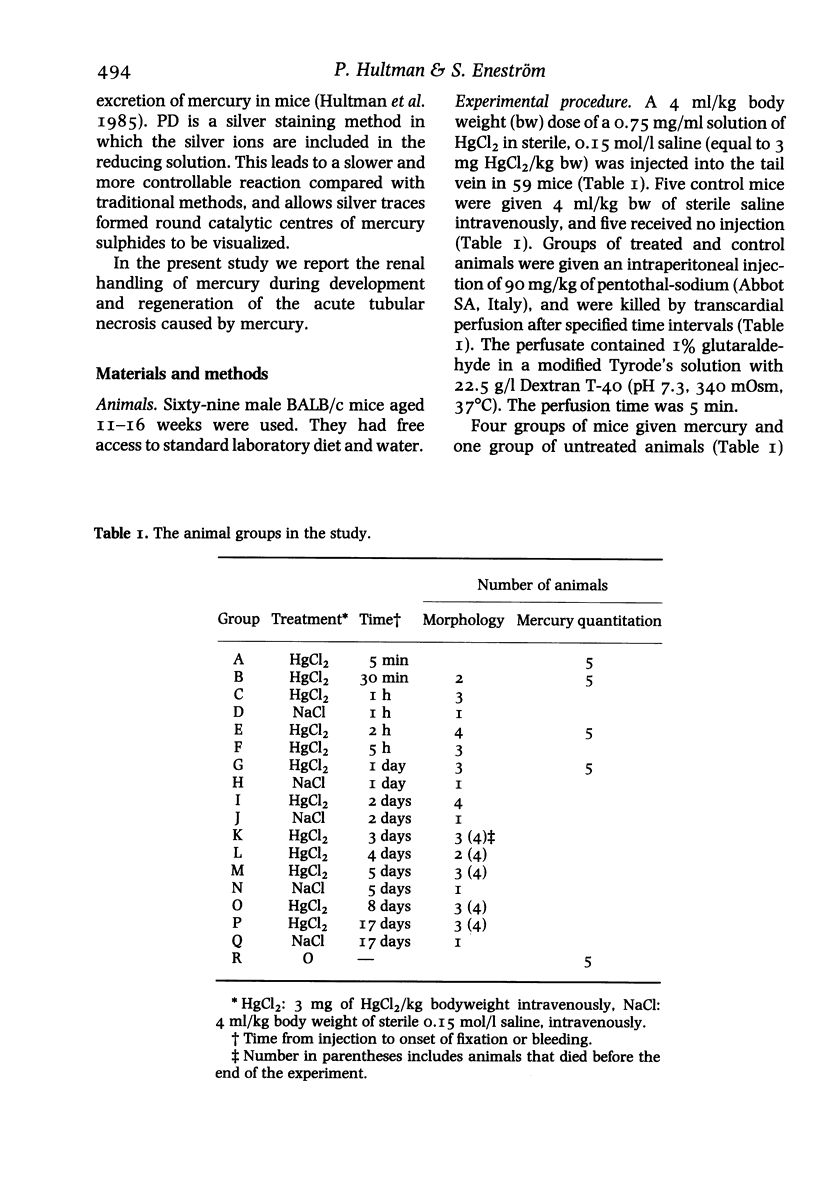Abstract
An intravenous injection of 3.0 mg HgCl2/kg bw was given to Balb/c mice. The concentration of mercury in the red blood cells, serum, and kidney was determined after 5 min, 30 min, 2 h and 24 h by atomic absorption spectrophotometry. The concentration of mercury in the serum showed a maximum after 5 min, and reached a constant low level after 30 min, whereas the concentration of mercury in the red blood cells gradually decreased and reached a similar low level at 24 h. The concentration of mercury in the kidney was greatest after 2 h and was markedly reduced at 24 h. The distribution of mercury in the kidney was followed for up to 17 days by the cytochemical Silver Amplification method applied at the light and electron microscopical levels. Mercury accumulated rapidly, but only in the proximal tubular epithelial cells, preferentially in the S2 and S3 segments. At the subcellular level mercury was only found in endocytic structures, and accumulated in the lysosomes. Very large mercury-containing lysosomes developed in the distal S3 segment. Cell necrosis was severest in the S2 and proximal S3 segments. Regenerated and differentiating epithelial cells in the proximal tubules still showed many mercury-containing lysosomes 17 days after the injection.
Full text
PDF










Images in this article
Selected References
These references are in PubMed. This may not be the complete list of references from this article.
- BERGSTRAND A., FRIBERG L., ODEBLAD E. Localization of mercury in the kidneys after subcutaneous administration; a study on rabbits with mercuric chloride and phenylmercuric acetate. AMA Arch Ind Health. 1958 Mar;17(3):253–256. [PubMed] [Google Scholar]
- Berlin M., Jerksell L. G., von Ubisch H. Uptake and retention of mercury in the mouse brain. A comparison of exposure to mercury vapor and intravenous injection of mercuric salt. Arch Environ Health. 1966 Jan;12(1):33–42. doi: 10.1080/00039896.1966.10664334. [DOI] [PubMed] [Google Scholar]
- Cember H., Gallagher P., Faulkner A. Distribution of mercury among blood fractions and serum proteins. Am Ind Hyg Assoc J. 1968 May-Jun;29(3):233–237. doi: 10.1080/00028896809342994. [DOI] [PubMed] [Google Scholar]
- Danscher G., Møller-Madsen B. Silver amplification of mercury sulfide and selenide: a histochemical method for light and electron microscopic localization of mercury in tissue. J Histochem Cytochem. 1985 Mar;33(3):219–228. doi: 10.1177/33.3.2579122. [DOI] [PubMed] [Google Scholar]
- Danscher G., Schrøder H. D. Histochemical demonstration of mercury induced changes in rat neurons. Histochemistry. 1979 Feb 26;60(1):1–7. doi: 10.1007/BF00495724. [DOI] [PubMed] [Google Scholar]
- Deter R. L., De Duve C. Influence of glucagon, an inducer of cellular autophagy, on some physical properties of rat liver lysosomes. J Cell Biol. 1967 May;33(2):437–449. doi: 10.1083/jcb.33.2.437. [DOI] [PMC free article] [PubMed] [Google Scholar]
- Eneström S., Hultman P. Immune-mediated glomerulonephritis induced by mercuric chloride in mice. Experientia. 1984 Nov 15;40(11):1234–1240. doi: 10.1007/BF01946653. [DOI] [PubMed] [Google Scholar]
- Ganote C. E., Reimer K. A., Jennings R. B. Acute mercuric chloride nephrotoxicity. An electron microscopic and metabolic study. Lab Invest. 1974 Dec;31(6):633–647. [PubMed] [Google Scholar]
- Gritzka T. L., Trump B. F. Renal tubular lesions caused by mercuric chloride. Electron microscopic observations: degeneration of the pars recta. Am J Pathol. 1968 Jun;52(6):1225–1277. [PMC free article] [PubMed] [Google Scholar]
- Kirschbaum B. B., Sprinkle F. M., Oken D. E. Renal function and mercury level in rats with mercuric chloride nephrotoxicity. Nephron. 1980;26(1):28–34. doi: 10.1159/000181946. [DOI] [PubMed] [Google Scholar]
- Komsta-Szumska E., Chmielnicka J., Piotrowski J. K. Binding of inorganic mercury by subcellllar fractions and proteins of rat kidneys. Arch Toxicol. 1976 Dec 23;37(1):57–66. doi: 10.1007/BF00353355. [DOI] [PubMed] [Google Scholar]
- Madsen K. M., Hansen J. C. Subcellular distribution of mercury in the rat kidney cortex after exposure to mercuric chloride. Toxicol Appl Pharmacol. 1980 Jul;54(3):443–453. doi: 10.1016/0041-008x(80)90171-4. [DOI] [PubMed] [Google Scholar]
- Maunsbach A. B. Observations on the segmentation of the proximal tubule in the rat kidney. Comparison of results from phase contrast, fluorescence and electron microscopy. J Ultrastruct Res. 1966 Oct;16(3):239–258. doi: 10.1016/s0022-5320(66)80060-6. [DOI] [PubMed] [Google Scholar]
- Naganuma A., Ishii Y., Nakama A., Endo R., Imura N. Effect of time intervals of selenium administration after injection of mercuric chloride on toxicity and renal concentration of mercury in mice. Ind Health. 1984;22(2):91–96. doi: 10.2486/indhealth.22.91. [DOI] [PubMed] [Google Scholar]
- RODIN A. E., CROWSON C. N. Mercury nephrotoxicity in the rat. 1. Factors influencing the localization of the tubular lesions. Am J Pathol. 1962 Sep;41:297–313. [PMC free article] [PubMed] [Google Scholar]
- Saxena M. C., Siddiqui M. K., Seth T. D., Krishna Murti C. R., Bhargava A. K., Kutty D. Organochlorine pesticides in specimens from women undergoing spontaneous abortion, premature of full-term delivery. J Anal Toxicol. 1981 Jan-Feb;5(1):6–9. doi: 10.1093/jat/5.1.6. [DOI] [PubMed] [Google Scholar]
- Taugner R., Winkel K zum, Iravani J. Zur Lokalisation der Sublimatanreicherung in der Rattenniere. Virchows Arch Pathol Anat Physiol Klin Med. 1966 Feb 22;340(4):369–383. [PubMed] [Google Scholar]
- Verity M. A., Reith A. Effect of mercurial compounds on structure-linked latency of lysosomal hydrolases. Biochem J. 1967 Nov;105(2):685–690. doi: 10.1042/bj1050685. [DOI] [PMC free article] [PubMed] [Google Scholar]
- WEED R., EBER J., ROTHSTEIN A. Interaction of mercury with human erythrocytes. J Gen Physiol. 1962 Jan;45:395–410. doi: 10.1085/jgp.45.3.395. [DOI] [PMC free article] [PubMed] [Google Scholar]
- Wattiaux-De Coninck S., Rutgeerts M. J., Wattiaux R. Lysosomes in rat-kidney tissue. Biochim Biophys Acta. 1965 Sep 20;105(3):446–459. doi: 10.1016/s0926-6593(65)80230-2. [DOI] [PubMed] [Google Scholar]








